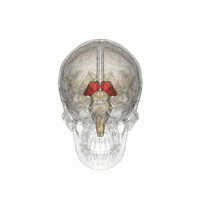
Photo from wikipedia
OBJECTIVE Although magnetic resonance-guided focused ultrasound (MRgFUS) at the ventral intermediate (VIM) thalamic nucleus is a novel and effective treatment for medication-refractory essential tremor (ET), it is unclear how the… Click to show full abstract
OBJECTIVE Although magnetic resonance-guided focused ultrasound (MRgFUS) at the ventral intermediate (VIM) thalamic nucleus is a novel and effective treatment for medication-refractory essential tremor (ET), it is unclear how the ablation lesion affects functional activity. The current study sought to evaluate the functional impact of MRgFUS thalamotomy in patients with ET, as well as to investigate the relationship between neuronal activity changes and tremor control. METHODS This study included 30 patients with ET who underwent MRgFUS thalamotomy with a 6-month follow-up involving MRI and clinical tremor rating. Additional sex- and age-matched healthy people were recruited for the healthy control group. The fractional amplitude of low-frequency fluctuation (fALFF) and regional homogeneity were used to identify functional alteration regions of interest (ROIs). To investigate changes after treatment, ROI- and seed-based functional connectivity (FC) analyses were performed. RESULTS Patients with ET had significantly increased fALFF in the right postcentral gyrus (PoCG; ROI 1), regional homogeneity in the left PoCG (ROI 2), and regional homogeneity in the right PoCG (ROI 3, cluster-level p value family-wise error [pFWE] < 0.05), which were recovered and normalized at 6 months after MRgFUS thalamotomy. FCs between ROI 2 and the right supramarginal gyrus, ROI 2 and the right superior parietal gyrus, and ROI 3 and the left precentral gyrus were also found to be increased after treatment (cluster-level pFWE < 0.05). Furthermore, changes in fALFF, regional homogeneity, and FC values were significantly correlated with tremor relief (p < 0.05). Preoperative FC strengths were found to be inversely related to the postoperative tremor control ratio (p < 0.05). CONCLUSIONS In patients with ET, the VIM lesion of MRgFUS thalamotomy resulted in symptom-related regional functional recovery associated with sensorimotor and attention networks. Preoperative FC strengths may reflect the postoperative tremor control ratio, implying that this metric could be a useful neuroimaging biomarker for predicting symptom relief in patients with ET following thalamotomy.
Journal Title: Neurosurgical focus
Year Published: 2022
Link to full text (if available)
Share on Social Media: Sign Up to like & get
recommendations!